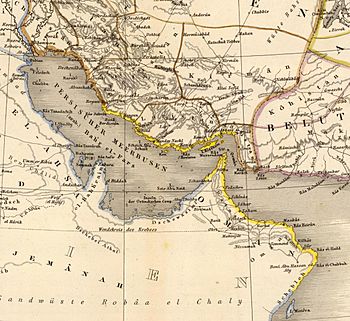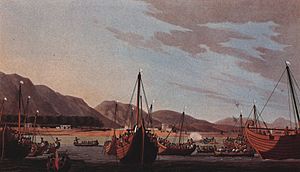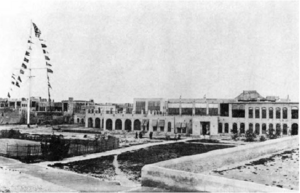Persian Gulf Residency facts for kids
Quick facts for kids
Persian Gulf Residency
المقيمية السياسية البريطانية في الخليج الفارسی
|
|
|---|---|
| 1822–1971 | |
|
Flag of the East India Company
|
|
 |
|
| Status | British Colonial Residency (1822–1947) Group of British protectorates (1947–1971) |
| Capital | Bushehr (1822–1946) Manama (1946–1971) |
| Official languages | English |
| Common languages | Arabic, Persian |
| Religion | Islam |
| States under Persian Gulf Resident |
|
| Government | Indirect colonial government |
| Chief Resident | |
|
• 1822–1823 (first)
|
John Macleod |
|
• 1970–1971 (last)
|
Geoffrey Arthur |
| History | |
|
• Established by the EIC
|
1822 |
|
• General Maritime Treaty
|
1820 |
| 1858 | |
|
• Transfer from Government of India to Foreign Office
|
1947 |
|
• Termination of the British protectorates
|
1971 |
| Currency | Indian rupee (1822–1959) Gulf rupee (1959–1966) Various (1966–1971) |
The Persian Gulf Residency (Arabic: المقيمية السياسية البريطانية في الخليج الفارسي) was a way the British Empire controlled parts of the Persian Gulf from 1822 to 1971. The United Kingdom had political and economic power over several states. These included what is now the United Arab Emirates (once called the "Trucial States"). It also included parts of Persia, Bahrain, Kuwait, Oman, and Qatar at different times.
Contents
How British Influence Grew
British interest in the Persian Gulf started in the 1500s. It grew as British India became more important to the British Empire. At first, Britain was mainly interested in trade. In 1622, the British fleet helped the Persian emperor Shāh Abbās remove the Portuguese from Hormuz Island. Because of this, the British East India Company (often called "the Company") was allowed to set up a trading post. This post was in Bandar 'Abbās, which became their main port in the Persian Gulf.

In 1763, the British East India Company set up a main office, called a residency, in Bushehr. This city was on the Persian side of the Gulf. Later, another office was opened in Basra. In 1807, a large French group arrived in Persia. This made Britain, both in London and Calcutta, very concerned. Britain sent a mission led by Sir Harford Jones. This led to a "Preliminary Treaty of Friendship and Alliance" with the Shah in 1809. This treaty helped shape how Britain and Persia dealt with each other for the next 50 years.
Britain appointed Harford Jones as their first official representative to Persia in 1808. Until 1860, most of these representatives came from the East India Company. The main British official in the region was called the "Political Resident." This person handled all talks with Persian leaders. Sir George Curzon even called him "the Uncrowned King of the Persian Gulf." The Political Resident had naval forces. He used them to stop piracy, slave trading, and illegal gun sales. He also enforced health rules and could send troops ashore in Persia.
In 1822, the Bushehr and Basra offices were combined. Bushehr became the main base for the new "British Resident for the Persian Gulf." This chief resident was in charge of the British presence. He reported to the Governor of Bombay until 1873. After that, he reported to the Governor-General of India until 1947. In 1858, the East India Company's role was taken over by the British government in India. This government then handled Britain's foreign policy with Persian Gulf states. In 1947, this job moved to the British Foreign Office.
The Trucial States and Peace Treaties
Britain's main goal in the Persian Gulf was trade. So, the British government in India was slow to protect British ships from Qawasim pirates. By 1817, these pirates were causing fear along the Indian coast. This led to a British military attack in 1819. The attack defeated the Qawasim group. On January 5, 1820, the General Maritime Treaty was signed. This treaty became the foundation of British policy in the Persian Gulf for 150 years.
The ruler of Bahrain and the sheikhs (leaders) along the northern coast of Oman agreed to keep peace with Britain. They also agreed to stop slavery and cruel treatment of prisoners. The treaty allowed ships from these tribes to enter British ports freely. This treaty helped Britain, but it also ended piracy in the Persian Gulf. The British Residency was allowed to act as a police force at sea. They made sure the treaty was followed and helped settle arguments between tribes.
In 1835, a system of truces (peace agreements) began. Raids by Bani Yas tribesmen, who were rivals of the Qawasim, led to a British-ordered truce. This truce was for the summer pearling season. It became a year-long truce in 1838 and was renewed every year until 1843. Then, it was extended for ten years.
This truce system became permanent with the "1853 Treaty of Maritime Peace in Perpetuity." At first, Britain did not get involved in the internal affairs of the Trucial sheikhs. But this changed with the "Exclusive Agreement" in March 1892. This agreement stopped the Trucial rulers from giving away land without Britain's permission. Britain also took over their foreign relations, which meant Britain would protect them. This treaty showed that Britain's focus had changed from trade to military and political control in the Trucial states.
After World War I
After World War I, the Trucial sheikhs' power to act on their own was limited by the British. This happened partly because Britain was focusing less on Iran. In Iran, Reza Shah was trying to gain more control, which weakened British power there. Britain also became more interested in air travel routes and communications.
For example, in 1922, the Trucial sheikhs agreed not to let anyone explore for oil in their lands. The only exception was "persons appointed by the British government." In 1937, the British Political Resident gave an even stricter order. It required Trucial states to only do business with Petroleum Concessions Ltd. This company was owned by the London-based Iraq Petroleum Company, which was partly owned by the Anglo-Iranian Oil Company (AIOC). This rule was not because Britain needed more oil. It was to stop other countries from getting involved in the Trucial States' economy and politics.
In 1946, the Persian Gulf Residency moved its main office from Bushehr to Bahrain. From this new base, the British Resident guided other British officials in Bahrain, Kuwait, Qatar, and Oman. This continued until these regions became independent.
What the Residency Did
On April 1, 1947, the British Political Residency came under the control of the Foreign Office. The Political Resident was like an ambassador in the Persian Gulf. He worked with a group of representatives called political agents. These agents worked in Bahrain, Qatar, Dubai, and Abu Dhabi. There were also political officers for the other Trucial states, working under the British Agency in Dubai. In Muscat, a Consul-General handled foreign relations. This person also reported to the Resident in Bahrain.
Through these agents, the Resident stayed in close contact with the Persian Gulf rulers. He protected their political and economic interests, as well as Britain's interests. This was all based on existing treaties and agreements. According to Rupert Hay, the sheikhs controlled their internal affairs. Britain "usually only got involved in matters that might cause problems with other countries, like civil aviation, posts, and telegraphs." However, Hay also said that Britain "constantly offered advice and encouragement" to rulers. This was to help them improve their governments and develop their resources.
The Resident also managed British extraterritorial jurisdiction. This meant that British law applied to certain people in the Persian Gulf since 1925. This power was given to Britain through informal agreements with rulers in the 1800s. In Muscat, it was based on formal agreements that were renewed often. At first, this British law applied to all foreign residents in the Persian Gulf states. Later, it was limited to British citizens, people from Commonwealth countries, and non-Muslim foreigners. Britain gave up this power in Kuwait on May 4, 1961. After that, Kuwaiti courts handled all foreigners.
The Resident also played a big role in oil agreements. He watched all talks for new oil deals or changes to old ones. He made sure nothing was decided that would seriously affect the rulers or the British government. Oil companies also had "political agreements" with the British government. These agreements made sure that the oil companies' important dealings with the rulers were done through, or with the knowledge of, British officials.
Areas Under British Protection
The Persian Gulf Residency oversaw several areas that became British protectorates:
- Trucial States, which later became the United Arab Emirates (1820–1971)
- Bahrain (1861–1971)
- Muscat and Oman (1892–1971) - Britain had limited control and involvement in their internal matters.
- Kuwait (1899–1961)
- Qatar (1916–1971)
Key Dates: 1763–1971
- 1763: The British East India Company sets up its first office (Residency) in Bushehr, Persia.
- 1798: The Sultan of Muscat signs a treaty giving the British East India Company special trading rights.
- 1809: Britain and the Shah of Persia sign a "Preliminary Treaty of Friendship and Alliance."
- January 8 – March 15, 1820: The "General Maritime Treaty" is signed with Britain and the sheikhs of the "Trucial Coast States" and Bahrain. This treaty aimed to stop the slave trade, piracy, and wars between the states.
- 1822: Britain officially establishes the Persian Gulf Residency.
- 1822 – 1873: The Residency reports to the Governor of Bombay.
- 1835: A treaty with the Trucial States creates a six-month truce each year during the pearling season.
- 1843: The 1835 treaty is renewed for ten years.
- 1853: A new treaty with the Trucial States makes the truce permanent.
- 1856 – 1857: The Anglo-Persian War takes place.
- 1858: The East India Company's powers are transferred to the British government in India.
- 1861: A protection treaty is signed with Bahrain.
- 1873 – 1947: The Residency reports to the Governor-General of India.
- 1873: Britain begins to manage the Trucial states.
- March 8, 1892 – December 1, 1971: Britain forms an informal protectorate with Muscat and Oman and a formal one with the Trucial States. The sheikhs give Britain control over their foreign policy in exchange for military protection.
- 1899: A protection treaty is signed with Kuwait.
- 1906: The Constitutional Revolution begins in Arabia.
- November 3, 1916: A protection treaty is signed with Qatar.
- 1920: The Treaty of Seeb is signed, recognizing the independence of the imamate of Oman.
- 1939: A British Residency office is established in the Trucial States at Dubai.
- 1946: The main office of the Persian Gulf Residency moves from Bushehr to Manama (Bahrain).
- 1947: As India gains independence, the Persian Gulf Residency is transferred to the British Foreign Office.
- 1961: Kuwait becomes fully independent.
- 1962: Great Britain declares Muscat and Oman an independent nation.
- January 1968: Britain announces it will leave the Persian Gulf, including the Trucial States, by 1971.
- December 16, 1971: British protection and military presence in the Persian Gulf officially end.
Important British Officials
The leaders of the Persian Gulf Residency were known as Political Agents and Chief Political Residents. They were responsible for managing Britain's interests and relationships in the region.
Chief Political Residents of the Persian Gulf: (These officials oversaw Bahrain, Kuwait, Oman, Qatar, and the Trucial States)
- 1822 – 1823: John Macleod (the first Chief Resident)
- 1838 – 1852: Samuel Hennell
- 1904 – 1920: Percy Zachariah Cox
- 1946 – 1953: Rupert Hay
- 1970 – 1971: Sir Geoffrey Arthur (the last Chief Resident)
See also
- Pax Britannica
- Bahrain Province




